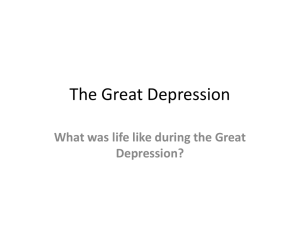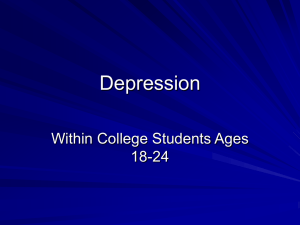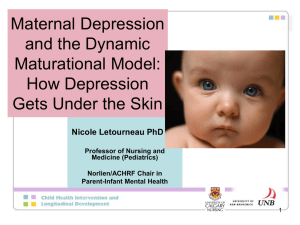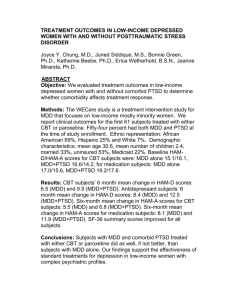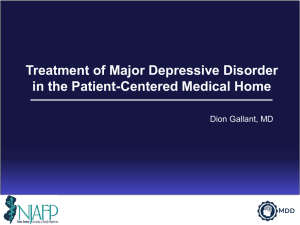Maternal Depression and its Impact on Maternal
advertisement
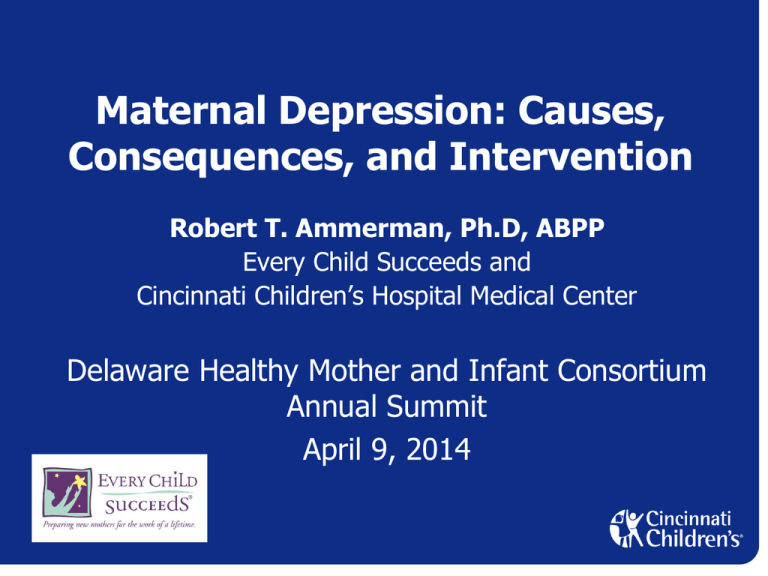
Maternal Depression: Causes, Consequences, and Intervention Robert T. Ammerman, Ph.D, ABPP Every Child Succeeds and Cincinnati Children’s Hospital Medical Center Delaware Healthy Mother and Infant Consortium Annual Summit April 9, 2014 Depression in Mothers • Determined by self-report – Edinburgh Postnatal Depression Scale – Center for Epidemiological Studies Depression Scale (CES-D) – Beck Depression Inventory-II (BDI-II) – Patient Health Questionniare-9 (PHQ-9) • Diagnosis of major depressive disorder (MDD) – Postpartum onset ≤6 months – Prenatal Symptoms of Major Depressive Disorder (MDD) • • • • • • • • • • • • • • • Sadness Crying Fatigue Disinterest Sleep problems Appetite problems Agitation or slowness Poor memory Poor concentration Low self-esteem Guilt Low motivation Hopelessness Suicidal thoughts Decreased libido CONSISTENT & PERSISTENT ≥2 weeks Phenomenology • Pervasive loss – – – – Loss of control Loss of self Social disconnection Loss of voice • Spiraling downward – – – – – – Anxiety Overwhelmed Rumination Obsessive thinking Anger Guilt From C.T. Beck, 2002 Phenomenology (cont.) • Expectations and reality – Shattered dreams – Failure & incompetence – Fear of negative evaluation • Making gains – Surrendering – Despair and hopelessness – Struggle Epidemiology of MDD • Lifetime prevalence for the general population is as high as 1 in 3, often begins in childhood or adolescence • Lifetime prevalence in women postpartum: 13-26% • Average length of episode: 3-6 months • Impairment: 87% report significant role impairment (social, home, relationships, work) • Comorbidity: 71% (anxiety disorders, substance use disorders) • Risk for subsequent episodes: 80% • Odds of relapse within 2 years: 50% • First episodes in postpartum period: 50% Associated Features • Nationally, 57% receive treatment. Only 64% get at least minimally adequate treatment. • 20-30% of women depressed postpartum receive treatment, less among low income. • Failure to successfully treat the first episode increases risk for subsequent episodes and increases likelihood of treatment resistant depression. • Suicide risk: between 4-15% Maternal Depression is Expensive Mother • Employment • Education • Health care utilization • Lifetime earnings Child • Preterm birth • Cognitive delays, special education • Mental health treatment • Injury and illness • Child abuse and neglect Maternal depression is a multigenerational issue. Economic Costs • World Health Organization (2012)—Depression is the leading cause of disability worldwide • Depression in adults costs $83.1 billion annually, including 31% direct medical costs, 62% workplace costs (absenteeism, presenteeism and disability) and 7% for suicide/mortality costs • Depressed employees miss 27.2 days of work per year • Maternal depression is associated with an increase in pre-term births which average $51,600 per birth • Family lifetime loss in income potential is $300,000 due to childhood onset of psychological problems • Identification and effective treatment saves money and protects investments in other programs. Depression 2 years Postpartum Measure: Edinburgh Postnatal Depression Scale Sample: 1,359 women over 2 years postpartum From Mayberry et al., 2007 Center on the Developing Child, Harvard University, 2009 Video Example Diagnostic Interview with a Depressed Mother in Home Visiting Risk Factors for Depression • History of depression • Cognitive and emotional vulnerability: pessimism, anxiety, low self-esteem • Stressful life events • Trauma history • Low social support • Poverty • Unmarried • Unwanted pregnancy Causes of Depression • • • • • Genetics Disruptions in HPA axis and stress response Sensitivity to hormonal changes Social disconnection Cognitive distortions Key Features of Infant Social and Emotional Development • Infants can imitate facial expressions and show preferences for caregivers. • Infants have a need to seek out communication with others. • Infants can elicit social and emotional responses from caregivers. Key Features of Infant Social and Emotional Development • Communication between mothers and infants is organized around face, voice, gesture, and gaze--“a dance”. • Secure attachment is the cornerstone of early social and emotional development. • Communication directly influences, and is influenced by, brain development and emerging physiological regulation. Key Features of Infant Social and Emotional Development • In normal mothers’ interactions with babies, 42% of time is spent exhibiting positive affect. For babies, 15% of time. • Mothers “guide” the quality of the interaction and the direction of development. They provide the scaffolding needed for successful development. Characteristics of Depressed Mothers • Withdrawn: disengaged, flat, unresponsive, little support. • Intrusive: rough, angry, interrupt • Unable to read cues. • Rejecting. • Imbalanced, discordant. Characteristics of Depressed Mothers • • • • • • • • Don’t enjoy parenting. View themselves as less competent and ineffective. View children as more difficult. Less tolerant. More likely to attribute inappropriate intent in children. See their behavior as caused by outside influences. Preoccupied, less attentive, don’t anticipate. Slower and less effective problem-solvers. Course of Depression & Development (illustrative) 1st episode 4 months 2nd episode 9 months 3rd episode 2 months 4th episode 3 months time Age 16 Baby born (age 20) = depressive episode child 1 year old = normal mood child 3 years old Impact on Infants and Development • Avoid mom, look away (for intrusive moms), docile, typically following maternal rejection. • Fussy, cries, focus on self-regulation (for withdrawn moms). • Crystallizing of communication patterns. • Delays in emotional regulation, and physiological organization. • Attentional problems. IMPORTANT: timing, length, severity, frequency, inter-episode functioning, partner support, other adults Exposure to Maternal Depression in Infancy & IQ 110 BOYS AT AGE 11 100 15 points 90 FSIQ 80 VIQ PIQ 70 60 50 No Dep at 3 mo Hay et al., 2001 Dep at 3 mo Video Example Mother-Child Interaction Using Still-Face Paradigm Treatment Options • • • • Antidepressant medications Interpersonal Psychotherapy Cognitive Behavioral Therapy Non-traditional and emerging: Listening Visits, yoga, mindfullness therapy, lay counselors Treatment Challenges • • • • • Treatment capacity Availability of evidence-based treatment Access and disparities Choice and engagement Antidepressant medications: adherence, effect on developing fetus, cost, trauma issues Moving Beyond Depression™ Overcoming barriers, fostering collaboration, and engaging depressed mothers in a non-traditional setting www.movingbeyonddepression.org Unique Opportunity in Home Visiting • Reach mothers who might not otherwise receive treatment. • Appeal to mothers’ interest in their baby’s development. • Lower barriers to treatment. • Identify mothers early in the MDD episode. • Leverage relationship between mother and home visitor. • Leverage ongoing and lengthy home visitation services to optimize outcomes. Course of Depression (BDI > 13 @ enrollment and/or 9 months) in home visitation (N = 806) 74.8% with trauma history Non-Dep Dep 55.8% 44.2% Ammerman et al., 2009 12% receive mental health treatment Essential Intervention Elements Ameliorate depressive symptoms Help mother and home visitor/service Collaborate with home visitor, no burden Implement in home to remove barriers Use evidence-based treatment Fit with population, setting, & service IH-CBT: Adaptations to Setting Overcome barriers to treatment to reach mothers Observe mothers in natural environment Observe important features that would not be evident in office Maximize learning and application of new skills Logistical challenges: privacy, other family, distractions Unexpected challenges and crises IH-CBT: Adaptations to Population New mothers with limited parenting experience Young mothers with few social supports Emerging adulthood Educational underachievement & lower IQ Cultural sensitivity Poverty and hardship Trauma history & intimate partner violence Psychiatric comorbidity IH-CBT: Adaptations to Service Collaborative relationship with home visitor Logistical coordination of multiple services Frequent contacts with home visitor Coordination of care Avoid triangulation Conceptual representation of IHCBT collaboration THERAPIST HOME VISITOR primarily depression domains primarily HV domains MOM Inclusionary: ECS participant ≥16 years old Baby 2<10 months EPDS ≥11 MDD using SCID MIDIS Design Screening: EPDS ≥11 Exclusionary: Substance depend. Psychosis Current suicidality Meds or therapy Eligibility/Pre-treatment Assessment SCID Diagnosis of MDD randomization IH-CBT 15 sessions + booster Ongoing home visitation Typical Home Visitation Community resources Ongoing home visitation Post-treatment Assessment 3 Month Follow-Up Assessment 34.8% received community treatment N=93 Retained: 86.8% ≥ 2 points: 95.6% Demographics of Sample (N=93) Mother Age: 22.0 (4.6) years Mother Race: Caucasian African American Asian American Hawaiian/Pacific Islander Native American 62.6% 34.1% 1.1% 1.1% 1.1% Mother Ethnicity: Appalachian Hispanic Mother Marital Status: Married Separated Single, never married 3.3% 7.7% 13.2% 1.1% 85.7% Demographics of Sample (cont.) Mother Education: 11.4 (1.9) years Number of Children 1 2-3 92.3% 7.7% Family Income: $ 0- 9,999 $10,000-19,999 $20,000-29,999 $30,000-39,999 $40,000-49,999 $50,000-59,999 54.8% 21.1% 16.4% 3.3% 2.2% 2.2% Baby Age (days): 154.5 (74.0) Clinical Features of MDD • MDD: 100% • BDI-II: 33.7 (10.1) EPDS: 18.9 (4.0) HDRS: 21.7 (4.6) • Severity— Mild: 28.9% Moderate: 46.7% Severe: 24.4% • • • • • Postpartum onset: 29.2% Recurrent: 75.3% # Episodes: 2.66 (1.59) Suicide attempts: 43.9% Age of 1st episode: 15.1 (5.2) years Current and Lifetime Comorbid Psychiatric Disorders 50% 45% 40% 35% 30% 25% 20% 15% 10% 5% 0% Current Past s. Di ia ex or An ia lim e Bu us Ab ug b. Dr ho .P ec Sp p. De c. Al p. De ug Dr e . ob us Ab Ph nic Pa c. Al D OC D GA c. So SD PT BDI-II Scores at Pre-Treatment, Post-Treatment, & Follow-Up 35 BDI-II Score 30 25 20 15 10 IHCBT THV 5 Pre Post FU Assessment Time Point F=7.9, p<.01 Not affected by therapist or home visiting model MDD Diagnosis at Pre- & PostTreatment & Follow-Up 100% 100.0%100.0% IHCBT 90% THV 80% 69.8% 70% 60% 52.6% 50% 40% 29.3% 30% 20.1% 20% 10% 0% Pre Χ2=19.0, p<.001 Post FU MDD Diagnosis at Pre-treatment, Post-treatment, & Follow-Up for Completers, Partial Completers, & THV 100% 100.0% 100.0% 100.0% Comp 90% <15 sess 80% THV 69.8% 70% 60% 52.6% 50% 44.4% 40.0% 40% 30% 21.7% 20% 9.5% 10% 0% Pre Post FU Social Support Using ISEL Scale (Total) IH-CBT THV 90 85 80 75 70 65 60 55 50 45 40 Pre F=5.1, p<.01 Post FU IH-CBT Client Feedback at Post-Treatment I feel more confident as a parent Happy with level of confidentiality Sessions in home were convenient Therapist and Home Visitor worked together to help me 0% 20% 40% 60% 80% 100% IH-CBT Home Visitor Feedback at PostTreatment Happy with level of confidentiality Therapist and I collaborated on case Therapist was available 0% 20% 40% 60% 80% 100% Predictors of symptom status at post-treatment 14 IH-CBT sessions 12 Home visits 10 8 6 4 2 0 Symptomatic BDI-II at post-txt: ≥9 Asymptomatic ≤8 Ammerman, R.T., Peugh, J.L., Putnam, F.W., & Van Ginkel, J.B. (2012). Predictors of treatment response in depressed mothers receiving In-Home Cognitive Behavioral Therapy and concurrent home visiting. Behavior Modification, 36, 462-481. Dissemination Massachusetts (4 sites) Kentucky (6 sites) Connecticut (4 sites) Kansas (1 site) www.movingbeyonddepression.org Acknowledgments • Frank W. Putnam, M.D. & Judith B. Van Ginkel, Ph.D. • Jack Stevens, Ph.D., Mekibib Altaye, Ph.D., James Peugh, Ph.D. • Jodie Short, Margaret J. Clark, M.P.A., Lawson Wulsin, M.D., Jennie Noll, Ph.D., Chad Shenk, Ph.D., Neil Richtand, M.D., Ph.D., Nicole Bosse, M.A., Angelique Teeters, Psy.D. • Healthy Families America and Nurse-Family Partnership • Grant support: National Institute of Mental Health (R34MH073867 & R01MH087499) • Every Child Succeeds agencies and home visitors! • Health Foundation of Greater Cincinnati • Kentucky H.A.N.D.S. & Ohio Help Me Grow • United Way of Greater Cincinnati • Xavier University, Dept. of Psychology www.everychildsucceeds.org





